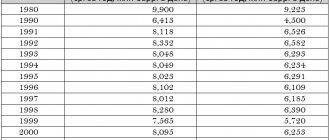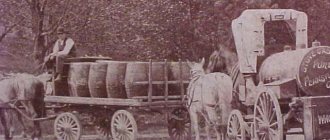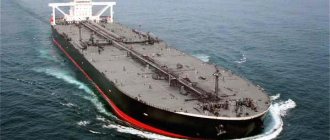What is a barrel of oil? And how much is it? The legend of the blue barrel and other interesting facts.
Unlike Russia, where the amount of oil and petroleum products is measured in tons, volumetric units are used on the international market - oil barrels .
American oil barrel is a unit of measurement of the volume of oil and petroleum products equal to 158.988 liters (or 42 gallons).
It is worth distinguishing between an oil barrel and a standard barrel, which is used to measure all other liquids (it is equal to 119.24 liters or 31.5 gallons).
General information about petroleum volume units
- So, one American barrel contains 158.988 liters.
This is a unit of volume , not mass, as many people mistakenly believe.
- And 158.988 liters is, in turn, 42 gallons.
- 1 gallon is 3.78543 liters (according to the American system). It should not be confused with the English gallon - its volume is slightly higher and equal to 4.55 liters.
Where did these designations even come from? The very concept of an oil barrel has been used since the time when crude oil was transported in barrels from the extraction site, and not by rail tank cars or entire tankers. And it was not in vain that the volume of the barrel was chosen this way - this is the size of the barrel that could be lifted/transported purely by human force (several people with special carts) for subsequent loading. And although today the times are no longer the same, the unit of measurement has remained the same.
And at the moment, it is the concept of the “American” barrel that is used as generally accepted. But its weight is not taken into account, since different brands of oil have different densities:
| Oil grade | Density (barrels per ton) |
| Urals | 7,24 – 7,33 |
| Siberian Light | 7,41 – 7,46 |
| Tengiz | 7,93 – 7,95 |
| Kumkol | 7,64 – 7,68 |
| Turkmen Blend | 7,37 – 7,41 |
It is worth noting that crude oil from US producers is reported in API gravity. And the number of barrels per ton is used mainly in the CIS countries.
Historical reference
Since the beginning of oil production, the need for its transportation has also arisen. At first, while the volume of transportation was small, there were no difficulties with containers: leather wineskins, barrels of various sizes and other improvised means were used. However, gradually the volume of oil production began to increase, and the problem of transportation and storage became quite acute. Then the most common containers were wooden barrels of various calibers.
Since oil was also sold in barrels, the lack of standard containers significantly complicated the paperwork process and gave rise to disputes between sellers and buyers.
In 1866, in the city of Titusville in Pennsylvania (it was here that Colonel Edwin L. Drake drilled his first well in 1859), a meeting of oil industrialists was held, one of the issues of which was the establishment of a single measure for oil supplies. It didn’t take long to think, and a 42-gallon barrel was adopted as a standard, successfully used for transporting and storing fish, wine, whale oil, oil, etc. Thus, the famous oil barrel (“barrel” - barrel, English) appeared .), firmly entrenched as a volumetric unit of measurement in the global petroleum industry.
The barrel of oil was officially approved as a standard in 1872 by the American Association of Petroleum Producers, and in 1882 by the American Geological Survey.
About the price of oil
The price of oil is always indicated in dollars per barrel. Moreover, news reports often mention the price of Brent oil, which is recognized as the standard (even though it accounts for only about 2% of the oil market). The price also affects “Russian” types of oil such as Urals or Siberian Light.
Interesting: Traditional economic system: its pros and cons. Is she that bad?
Why is the price quoted per barrel? Because it is the volume of oil that is estimated. And from this (and also knowing the grade and conditional density) you can calculate approximately how many petroleum products can be obtained from such a unit of volume. It will not be possible to calculate the final profit from the mass, since it is customary to evaluate the same gasoline, fuel oil, diesel in liters, like any other liquid. After all, few people are interested in the fact that 1 liter of the same automobile gasoline contains approximately 710-750 grams.
How is the price of oil regulated? For the most part, this is influenced by the political and economic agreement between countries. Essentially, the final price of crude oil is affected by:
- volume of production (and it is precisely politicians who determine it);
- variety;
- the political situation between the countries that are the main suppliers of crude oil (these are the United States, Russia, the UAE, Qatar, and so on).
Until the 70s of the last century, the cost of each barrel ranged from 20 to 40 dollars; starting from the 80s, it sharply increased to almost 100 dollars. In 2015-2016, it decreased again (due to an increase in the number of supplies, which was provoked by the United States as sanctions).
Capacity
The main characteristic that allows ships to be classified by size is deadweight (DWT) or the total carrying capacity of the ship. It indicates the weight in tons that can be taken on board up to the summer load waterline. Also, when dividing tankers into categories, the navigation situation is taken into account, for example, the depth in the straits and reception ports, and the size of the locks.
Screen: classification by type of cargo
Small-tonnage tankers with a capacity of 10,000–45,000 tons are designed to transport refined petroleum products. The minimum capacity of a vessel for transporting raw materials is 45,000 tons, which translates to 327–343 thousand barrels.
Table 1. Maximum size of oil tankers according to the flexible market scale
| Category | DWT, tons | Grade, barrel (approximately) | ||
| WTI | Brent | Urals | ||
| Panamax | 80 000 | 586 510 | 609 756 | 582 665 |
| Aframax | 120 000 | 879 765 | 914 634 | 873 998 |
| Suezmax | 200 000 | 1 466 275 | 1 524 390 | 1 456 664 |
| VLCC (Very Large Crude Carrier) | 320 000 | 2 346 041 | 2 439 024 | 2 330 662 |
| ULCC (Ultra Large Crude Carrier) | 550 000 | 4 032 258 | 4 192 073 | 4 005 826 |
To calculate the indicators, the calculator for converting barrels to tons pronpz was used.
Did you know that such huge oil tankers exist?
Not really
Material on topic! How much do oil workers earn in Russia and the world?
Barrel designation
The traditional abbreviation for an American barrel is bbl. Translation – blue barrel. Why “blue”? It is believed that this name “stuck” due to the fact that the oil industry used to transport crude oil in blue barrels. And even then, the invoices indicated the volume of oil in bbls, that is, the number of blue tanks transported, 42 gallons each.
Oil transportation by Standard Oil
It is also interesting that among Russian companies prices for crude oil are indicated in tons. Calculations based on documents are also carried out according to this scheme.
Barrel
1.
A round vessel made of wood staves or of sheet metal. Barrels had a greater length than diameter and those of wood bulged in the middle.
2.
A unit of volume. There are no worldwide standards of size, and the official values may change through time. US wine barrel volume (1920s) was thirty-one gallons. The beer barrel volume was thirty-one and half gallons, and the British imperial beer barrel contained thirty-six gallons. At the end of the twentieth century, a barrel of oil was forty-two gallons and a barrel of water was thirty-one and a half gallons. In 1866, a gallon was listed in Sweet's Ready Reckoner (US) as containing 277.25 cubic inches. By 1920, a US gallon contained 231 cubic inches and, at the beginning of the twenty-first century, still contained 231 cubic inches.
Why is it more convenient to use barrels?
Russian mining companies, in fact, also use the concept of “barrel”, since it is convenient to show the amount of volume produced in one year. For example, if 1 barrel is extracted from a well every day, this indicates that within a year it will be possible to obtain from it, on average, 50 tons of Urals crude oil - it is the main one for Russian exporters.
Interesting: CAGR: what is this indicator and how to calculate it
To summarize, 1 barrel is a unit of volume and is equal to 158.988 liters or 42 gallons. This value is equal to the volume of an oil barrel that was previously transported to oil refining companies. This measure has been used for more than 100 years.
So how many barrels are in a ton?
As mentioned earlier, the number of barrels depends on what grade the black gold belongs to. Both OPEC and the CIS countries have their own classification. According to yearbooks published by the Organization of Petroleum Exporting Countries, a ton of Saudi fossil fuel contains 7.6 barrels, and if counted backwards, a barrel contains 0.132 tons of hydrocarbons.
Algerian oil is slightly lighter - one ton fits into 7.9 barrels, and if we again take the inverse value, then 1 barrel is equal to 0.126 tons of black gold.
Many well-known international publications that publish conversion factors from tons to barrels take Russian oil into account not as a weighted average of Ural and Siberian oil, but as an arithmetic average. On the one hand, this is not entirely correct, but no one is revising the established standards. Thus, it turns out that 1 barrel of black gold for Russian hydrocarbon raw materials is 137 kg.
Source
Dependence of the amount of oil on its density
To reveal this secret, it is necessary to remember the elementary meanings that are characteristic of any substance and affect its state. Density is a physical quantity equal to the ratio of body mass to volume, measured in g/cm³ and kg/m3. This definition is familiar to everyone from school days, and many laws of physics are associated with this term.
The ability of objects to float on the surface of water, the determination of fluid tension and many other concepts depend and are determined solely by the value of density. Oil, a substance whose normal state corresponds to the term “liquid,” was no exception to the general rule. It is the differences in oil density values, due to historical and geological reasons, that influence some of the digital spread in terms of tons.
Due to the fact that the density of "black gold" is not a single value and varies depending on where it is mined, there are some differences in translation. And since the density of oil directly depends on its temperature, this is also taken into account in the recalculation process.
About popular types of tankers
The cost of a new modern vessel, depending on the size, varies from $43 million to $120 million.
Reference! The history of shipbuilding goes back hundreds of years, but the transport of liquid cargo in tankers began only in 1877. Humanity owes the invention to the Nobel brothers: the metal ship “Zoroaster”, built by their order, was used to transport kerosene from Baku to Volgograd (Tsaritsyn).
Panamax
This category includes ships whose dimensions allow the passage of the canal connecting the Bay of Panama with the Caribbean Sea and the Atlantic Ocean. According to the Marine News of Russia website, in 2014 the total number of oil tankers was 415. The carrying capacity of such containers is 60–80 thousand tons, which is an average of about 550–600 thousand barrels, depending on the type.
I wonder how many oil reserves there are in Russia
Aframax
The group received its name thanks to the average freight rate assessment system (AFRA) for standardizing the terms of contracts for transportation, which was developed by Shell Oil. The size of tankers that fall into this category allows them to be serviced in a large number of ports around the world. They are used in the basins of the North, Black, Caribbean, and Mediterranean seas and can transport up to 873–915 thousand “barrels.”
Suezmax
Lift tankers are used on longer routes, for example from oil production sites in the North Sea to the USA and China, as well as transport from Nigeria. The vessels are large enough to pass through the Suez Canal, which connects the Mediterranean and Red Seas. It is he who helps shorten the path from the oil-rich East to its main consumers - Europe and America. The total number of giants holding up to 1.5 barrels in the world is about 490 pieces.
VLCC
Photo: Kuwait Oil Tanker
According to Rossiyskaya Gazeta, these ships are responsible for the majority of the world's oil transportation: they transport fuel from main production sites to large refiners over long distances. They operate routes to ports in West Africa and the Mediterranean, some passing through the Northern Terminals. Can pass through the Suez Canal. Average capacity up to 2.4 million barrels.
Oil trading
The Brent brand is recognized as the standard. This is what is indicated in financial reports. Although its share accounts for only 2% of the black gold market.
The following are the world's largest oil exchanges:
- New York Mercantile Exchange (NYMEX). Sometimes it is called American.
- London Petroleum Exchange (LPE). Sometimes called European
- Singapore International Monetary Exchange (SIMEX). Sometimes called Asian.
The size of one oil contract is 1000 barrels. The entire market is built on futures (that is, future deliveries).
A Russian trader can access the commodity market through a stock broker. For work I recommend the following:
- Finam (promotion: Free Trade tariff, trading without commission forever)
- BCS Broker
These are the best brokers for trading on the stock market, which provide services to a large part of traders in Russia. They have the best conditions, the lowest commissions for trading, there are offices throughout Russia, large customer support service, free deposits and withdrawals. Here you can buy foreign shares, follow the strategies of professionals, and so on.
Oil exchange rate chart in dollars:
Brent exchange rate chart in rubles:
Conversion to other units of measurement
It is often necessary to convert barrels into tons, and here a factor such as oil density comes into play, which for the main types of oil in Russia, for example, varies widely - from 820 to 905.5 kilograms per cubic meter. The mass of each barrel changes accordingly. The conversion coefficient from tons to barrels for Russian Urals oil, the main grade of Russian oil shipped for export, is 7.28 barrels/ton. A similar coefficient for light Brent oil (UK), at a discount to which Urals is sold on the world market, is 7.59 barrel/ton.
What can you get from a barrel of oil?
To more clearly understand the capabilities of a barrel of oil, it is necessary to consider the amount of products obtained during its processing. So, it will turn out:
- gasoline - 102 liters;
- diz. fuel – 30 liters;
- aviation fuel – 25 liters;
- refinery gas – 11 liters;
- petroleum coke, which is used for the production of electrodes and anti-corrosion equipment - 10 liters;
- fuel oil – 7 liters;
- liquefied gas - 5.5 liters;
- charcoal - 1.5 kilograms;
- propane gas – 12 cylinders;
- motor oil – 1 liter;
- wax candles for cake – 120 pieces.
Among other things, petroleum products have a huge range of applications in various other areas. Pharmaceuticals, plastics, cosmetics, food production - all this is just a small part of the possibilities that a barrel of oil is capable of.
Volume calculation
Liquid displacement method
The volume of an object can be calculated using the fluid displacement method. To do this, it is lowered into a liquid of a known volume, a new volume is geometrically calculated or measured, and the difference between these two quantities is the volume of the object being measured. For example, if when you lower an object into a cup with one liter of water, the volume of the liquid increases to two liters, then the volume of the object is one liter. In this way, you can only calculate the volume of objects that do not absorb liquid.
One unit with different meanings
In parallel with the oil barrel, in the United States there is also a barrel for measuring other liquid and bulk products, which holds only 31.5 gallons (119.237 l). There is also a so-called dry barrel - 115.6 liters and a beer barrel with a capacity of 31 gallons (117.3 liters).
The English barrel maintains the cultivated identity of the island nation and differs from the American barrel with a capacity of 163.65 liters. France also has its own barrels for wine products called “barriques”, with a volume of 225-228 liters depending on the province.
The barrel is also a national unit of volume in Argentina and Haiti, and a unit of liquid volume in Mexico, Paraguay and Uruguay, again with very different displacement "barrels".
Historically, in the international market, barrels, rather than liters, are used to measure the volume of petroleum products and other liquid, bulk substances. This word is of English origin; translated it means “barrel”.
The barrel has long been used in Western European countries and their former colonies to measure a wide variety of liquid and bulk substances. Beer, ale, oils, gunpowder - all this was measured in barrels. It is noteworthy that in the Russian Empire there was an analogue of a barrel, which was equal to 40 buckets or 491.96 liters.
"Bochka" is a Russian unit of measurement used in the 19th century.











